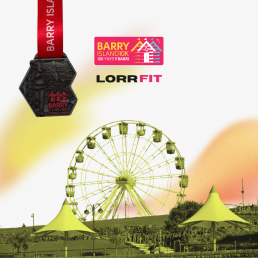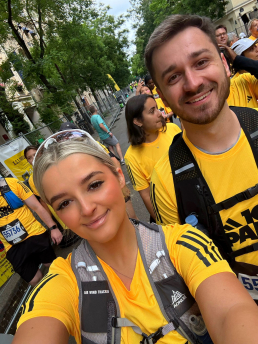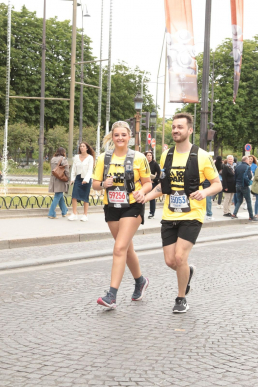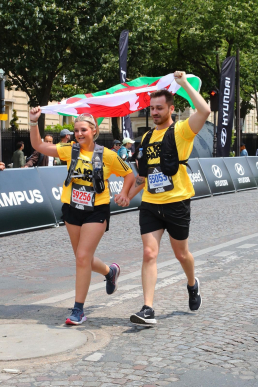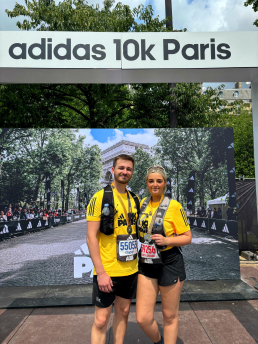CDF - Cardiff 10k 2025
I’m not going to lie… heading into the Cardiff 10k, I felt totally unprepared. I hadn’t run since the London 10k and hadn’t trained one bit. But somehow, despite all of that, I crossed the finish line with a time close to my pre-crash race times, and I can’t explain how happy that made me.
It felt like a tiny breakthrough. Little by little, I’m getting there. My confidence is creeping back, my pace is starting to resemble what it once was, and for a brief moment during the race, I felt like myself again.
But the reality of my ongoing recovery hit hard afterwards. My neck pain was awful! so bad that I had to use my massage gun, take painkillers, and nap just to ease it. It’s frustrating living with this constant pain since the crash. Sometimes I wish I could just go back to “normal,” to run without thinking about how my body will respond afterwards.
With the Cardiff Half Marathon only a month away, my anxiety is definitely bubbling. I can see the progress, but I’m still nervous about how my body will perform during (and after) the race. Still, this 10k reminded me that I am moving forward, even if it’s slow and messy.
Step by step, race by race, I’m clawing my way back. And that feels like a win worth celebrating.
London 10k 2025
Just a week after the Porthcawl 10k, I was back at it again, this time for the London 10k 2025. And honestly? This one felt different. For the first time since my crash, I experienced that euphoric race feeling I’d been missing.
The vibes were amazing! Crowds lining the streets, the energy of London buzzing all around, the kind of atmosphere that lifts you even when you’re not chasing a PB. I went into this race with zero pressure, fully aware that I’ve been running in pain for a long time now. And because of that, it became about enjoyment, not speed.
At the 5k mark, I even had to make a quick pit stop (yes, I peed) and then headed to the St John’s Ambulance tent for some Vaseline to battle the chub rub (iykyk, girlies). After that, though, I felt great and just let myself soak it all in.
This was also a solo race for me, but I wasn’t really alone. My good friend Amy was there on the sidelines, cheering me on, and I can’t tell you how much I appreciated that support. Friendships like this make races feel even more special.
Crossing the finish line in London felt like a turning point. I wasn’t chasing a time, I wasn’t running from pain, I was running with joy again. And that, to me, is priceless.
Here’s to more euphoric races, more supportive friends, and remembering why I fell in love with running in the first place.
Porthcawl 10k 2025
Just over a month after the Barry 10k, I lined up at the Porthcawl 10k — my first race running completely on my own since the crash. Kyle was running too, but separately this time. This felt like a big step for me: no safety net, no one to lean on mid-race, just me, my body, and my mind.
And honestly? It was a mental battle from start to finish. Not only am I still running through pain, but this week I found out I’m being made redundant after four years at an agency. That news knocked my confidence hard. I’ve been filled with self-doubt, questioning my worth, and feeling like I’m not good enough.
But something shifted during this race. Halfway through, when my legs were tired and my brain was spiralling, I decided to flip the script. I turned my anger, my hurt, and my fear into determination. I pushed, kilometre by kilometre, telling myself: I can do this. I am good enough.
Crossing the finish line at Porthcawl felt bigger than just another medal. It felt like proof that even when my mental health is in the gutter, I can still rise. That even with pain, uncertainty, and self-doubt, I can finish what I started.
This race taught me that running isn’t just physical. It’s a lifeline, a release, and a way to take back control when everything else feels out of my hands.
Here’s to using the hard moments as fuel — and reminding ourselves that we’re stronger than we think.
Barry 10k 2025
Just a week after the Paris 10k, I found myself lacing up again — this time for the Barry 10k. If I’m honest, it was almost as tough as Paris. My body was still recovering, and while the pain was slightly less intense, it was still very much there. Every kilometre felt like a mental battle.
But once again, Kyle was by my side. After helping me through Paris, he showed up for me in Barry, pacing me, encouraging me, and reminding me to be kind to myself. I’m still rebuilding after the car crash, still finding my way back to strength, and still learning to listen to my body.
This wasn’t about chasing a PB or proving anything. It was about showing up, trying again, and finding the courage to keep going despite the pain. And in that way, Barry became a stepping stone — a little sign of progress, a small but important victory.
Running two 10ks back-to-back after everything my body has been through was never going to be easy. But crossing that finish line, even slower than usual, reminded me how much I love this sport and how grateful I am for the people who support me through it.
Here’s to healing, persistence, and the slow climb back to where I want to be.
Paris 10k 2025
The Paris 10k this June was supposed to be a milestone for me; my first long race with my partner Kyle, and my first race abroad since the car crash. And while it was beautiful and special in so many ways, it was also one of the hardest runs I’ve ever done.
From the start, I knew this race was going to be different. I was still carrying the aftermath of the crash, over a month out of proper training, still struggling with whiplash, and not feeling anywhere near my best. By 8k, the pain set in like nothing I’d felt before. It all seemed to centre in my core, almost like I’d hurt my coccyx bone (though I hadn’t). I’d never experienced pain like it in a 10k, and I was so embarrassed at how slow I was going.
But then there was Kyle. Every step of the way, he reminded me that even showing up was brave. That most people in my situation would’ve cancelled their entire race calendar. That it wasn’t about the pace, but about crossing that finish line, together. And with his patience and encouragement, I did just that.
It ended up being my slowest 10k to date, but also one of the most meaningful. Because it wasn’t just about running, it was about resilience, about love, and about proving to myself that even when things feel impossible, I can push through.
Outside the race, we turned it into a beautiful Parisian trip. Our first holiday abroad together as a couple — full of romance, fun, and memories I’ll treasure forever. If anything, I just wish we had more time there.
Paris tested me physically, but it also gave me a deeper appreciation for support, patience, and the strength that comes not just from running, but from running with someone who truly has your back.
40s Baby - £25.00
40s Baby
£25.00
Step back in time with this striking pop art portrait of a woman, blending 1940s-inspired style with a modern digital twist. This artwork features a traditional pencil drawing digitally enhanced, showcasing brown hair, bold red blush, and imperfect red lipstick for a rebellious edge.
The old newspaper ink-style background gives it a vintage, textured feel, while a vibrant yellow paint swoop across the eyes adds a dramatic pop of colour and mystery. Perfect for lovers of retro aesthetics, pop art collectors, or anyone seeking a statement piece that fuses nostalgia with contemporary artistry.
Style
Traditional pencil drawing + digital pop art
Subject
1940s-inspired woman with red lipstick & blush
Background
Old newspaper ink-style texture
Series
Pop | Nostalgia - Bold, retro, and expressive


Defender - £25.00
DEFENDER
£25.00
Celebrate adventure and classic design with this hand-drawn digital illustration of a Grey Land Rover Discovery, set against a subtle light blue-grey background. The clean, modern backdrop enhances the rugged yet refined lines of the vehicle, making it a perfect piece for car enthusiasts, off-road lovers, or anyone who appreciates iconic automotive style.
Part of our Automotive / Vehicle Series, this artwork adds a touch of personality to home décor, offices, or garages — and makes an excellent gift for Land Rover fans.
Style
Hand-drawn digital illustration
Subject
Grey Land Rover Discovery
Background
Light blue-grey
Series
Automotive / Vehicle Series


Dalmatian - £25.00
DALMATIAN
£25.00
Bring a splash of colour and personality to your space with this hand-drawn digital portrait of a Dalmatian dog, captured with its tongue out in a playful and charming expression. The bold, vibrant purple background enhances the unique black-and-white coat of the Dalmatian, making it a striking piece for any dog lover or art enthusiast.
Part of our exclusive Dog / Pet Series, this artwork is perfect for home décor, office spaces, or as a thoughtful gift for pet owners who adore this iconic breed.
Style
Hand-drawn digital art
Subject
Dalmatian dog with tongue out
Background
Bold and vibrant purple
Series
Dog / Pet Series


Why It Took Decades to Test Female Crash Dummies – And the Deadly Risk Women Still Face

It’s 2025. We’ve got AI companions, billionaires in space, and yet… women are only just being accurately included in car safety testing. Shocking, isn’t it?
For decades, the standard crash test dummy has been based on the “average male body” — and that’s had devastating consequences for women behind the wheel or in the passenger seat. It’s a disturbing oversight, and one that’s only recently started to be addressed.
The Gender Bias in Crash Testing
Crash test dummies have existed since the 1950s. But for the majority of that time, they’ve been designed around the male anatomy — typically based on a 76kg, 1.77m tall man. The problem? That doesn’t reflect half the population.
It wasn’t until 2011 that a smaller “female” dummy began being used in U.S. tests — but even that version was simply a scaled-down male dummy, not accurately representing female physiology. In Europe, the situation has been much the same.
In 2022, Swedish researchers developed the world’s first crash test dummy designed to reflect the average female body, accounting for differences in:
- Muscle mass and strength
- Pelvic structure
- Neck size and strength
- Sitting posture
And the results were eye-opening.
Women Are More Likely to Die or Be Injured
Because of these design flaws, women are at a significantly higher risk of injury or death in car accidents.
According to a 2019 study by the University of Virginia:
- Women are 73% more likely to be seriously injured in a car crash.
- They are 17% more likely to die in the same crash scenario as a man.
These aren’t small margins — they’re life-threatening gaps in safety that have gone unaddressed for far too long.
Why Has It Taken So Long?
The short answer: systemic bias.
The auto industry, historically dominated by men, has long seen the “male” body as the default. Car designs — from seat belts and airbags to headrests and dashboards — have been tailored to male proportions. Meanwhile, female bodies were seen as outliers or variations, not a core part of the safety equation, and we still don’t have pregnancy safety seatbelts.
There’s also the issue of regulatory lag. Even though new female-specific crash test dummies exist, they’re still not required in many official safety tests. That means many manufacturers aren’t using them unless pressured to do so.
The Push for Change
In the UK and EU, awareness is slowly growing. The European New Car Assessment Programme (Euro NCAP) has begun revising its protocols, and researchers like Dr. Astrid Linder (featured in the BBC article) are pushing for sex-specific crash testing to become a global standard.
Dr. Linder’s research has been pivotal in showing that differences in how men and women move during a crash — especially in whiplash scenarios — demand better representation in crash simulations.
But change needs to be systemic, not symbolic.
What Needs to Happen Next
For true equity in car safety, we need:
- Female crash dummies required in all crash tests — not just optional extras.
- Updated regulations reflecting the average dimensions and biomechanics of women.
- Inclusion of diverse body types, including pregnant women, elderly passengers, and various body sizes.
- Transparent data on how vehicles perform for all genders — not just men.
Final Thoughts
It shouldn’t take decades to realise that safety should apply to everyone equally. Women have been literally dying from being left out of the testing process. And for all our talk of equality and progress, something as fundamental as car safety still reveals the blind spots of a male-centric world.
Since I’ve recently been in a car collision myself and have had my own experience, I remembered about this design safety feature, which is unfortunately still not in all cars around the world and that still affects nearly half of the world population and motor users.
At Flaminky, we believe visibility matters. Whether it’s crash dummies, representation in tech, or storytelling — including everyone isn’t a luxury. It’s a basic right.
Let’s hope the auto industry finally gets the crash course it desperately needs.
Life Can Change in a Second
On May 10th, I was in a four-car collision that I can only describe as the most terrifying and stressful experience of my life. I haven’t fully processed it yet — and maybe I won’t for a while — but I wanted to write this not just to share what happened, but to highlight what often gets overlooked: the aftermath.
I was driving on the slip road westbound by the tunnels in Cardiff Bay. The car in front of me suddenly emergency stopped, because the car in front of them had stopped on the dual carriageway to let someone in from the slip road… even though they had the right of way.
I slammed on my brakes and just lightly bumped the taxi in front. It could’ve ended there. But two cars came speeding out of the tunnel behind me — and all they saw was stationary traffic. They hit me at 70mph, twice — once into the right rear of my car, and again into the driver’s side door.
Their airbags deployed.
Mine didn’t.
And somehow, I walked away from that crash.
But not unscathed.
Since that day, I’ve been dealing with daily migraines, whiplash, nightmares, PTSD flashbacks, and a fear of slip roads and cars driving close behind me. I’ve lost my confidence on the road. I feel anxious in places I never did before.
Please, don’t speed in tunnels.
The signs are there for a reason.
Please don’t stop unnecessarily on dual carriageways. If it’s your right of way — take it. Stopping without cause nearly cost lives that day.
I hit my head on the seatbelt panel, and I distinctly remember the feeling — my brain moving inside my skull. I’ve since spoken to medical professionals who confirmed what I felt: “If it felt like it moved, then it did.” Your brain isn’t fixed in place — it floats in fluid. And it’s fragile. So, so fragile.
I’ve come away from this experience with a new perspective on how delicate life is, and how quickly everything can change. I appreciate life more. I appreciate the people who showed up and checked in — and I now know who truly cares.
But it hasn’t just been the crash that’s been hard — it’s everything after:
-
Hearing the car I saved to buy myself is now written off.
-
Police statements and crash investigations.
-
A WalesOnline article about the crash.
-
Insurers, car hires, and trying to find a new car in less than two weeks.
-
Medical appointments, hospital waiting rooms, therapists, solicitors.
-
Missing work.
-
The financial pressure of replacing a car when the crash wasn’t even my fault.
I was just in the wrong place, at the wrong time.
And the emotional toll is real.
I’ve now been told I need to slowly phase back into physical activity. Head trauma isn’t something you bounce back from overnight. It’s been two weeks without fitness — which for someone like me who finds movement essential for mental health, feels unbearable.
But this week I’m easing in with yoga, and later on I’ll reintroduce running — gently, mindfully. I do have the Paris 10k coming up in three weeks with my boyfriend, and while I’m excited, I’m cautious too. He’s been incredibly supportive, reminding me:
“Health comes before medals — always.”
** Just wanted to add that I am incredibly thankful, grateful to the people who have supported me during this time. Especially to my dad, who has helped me throughout this process and the admin of the aftermath, that’s all new and alien to me. His support has meant the world to me, and I honestly don’t know where I’d be during this whole process without him.
So I’m taking it one day at a time. Healing doesn’t follow a straight line. If you’ve ever been through a traumatic accident, please know that it’s not just okay, but necessary, to ask for help. To feel it all. To go slow.
And if you’re reading this — thank you. Whether it’s to be informed, to feel less alone, or to remember to slow down behind the wheel — I hope it helps. ❤️
Stay safe. Slow down. Life is precious.
– Lorr x




